AMD Radeon HD 7870 GHz Edition & Radeon HD 7850 Review: Rounding Out Southern Islands
by Ryan Smith on March 5, 2012 12:01 AM ESTOverclocking: Power, Temp, & Noise
As with the rest of Southern Islands, AMD is making sure to promote the overclockability of their cards. And why not? So far we’ve seen every 7700 and 7900 card overclock by at least 12% on stock voltage, indicating there’s a surprising amount of headroom in these cards. The fact that performance has been scaling so well with overclocking only makes overclocking even more enticing. Who doesn’t want free performance?
So how does Pircairn and the 7800 series stack up compared to the 7700 and 7900 series when it comes to overclocking? Quite well actually; it easily lives up to the standards set by AMD’s previous Southern Islands cards.
| Radeon HD 7800 Series Overclocking | ||||
| AMD Radeon HD 7870 | AMD Radeon HD 7850 | |||
| Shipping Core Clock | 1000MHz | 860MHz | ||
| Shipping Memory Clock | 4.8GHz | 4.8GHz | ||
| Shipping Voltage | 1.219v | 1.213v | ||
| Overclock Core Clock | 1150MHz | 1050MHz | ||
| Overclock Memory Clock | 5.4GHz | 5.4GHz | ||
| Overclock Voltage | 1.219v | 1.213v | ||
Overall we were able to push our 7870 from 1000MHz to 1150MHz, representing a sizable 15% core overclock. This is now the 3rd SI card we’ve hit 1125MHz or 1150MHz – the other two being the 7970 and the 7770 – so AMD’s overclocking headroom has been extremely consistent for their upper tier cards.
As for memory overclocking, we hit 5.4GHz on both cards before general performance started to plateau, representing a 12.5% memory overclock. Considering that both cards use the same RAM on the same PCB, and the performance limitation is the memory bus itself, this is consistent with what we would have expected. With that said, we are a bit surprised that we got so far over 5GHz on 2Gb GDDR5 memory chips only rated for 5GHz in the first place; it indicates that Hynix’s GDDR5 production very mature.
With that said, because of the unique and non-retail nature of the 7850 AMD supplied us, the 7850 overclocking results should be considered low-confidence. The retail 7850 cards will be using simpler and no doubt cheaper coolers, PCBs, and VRMs; all of these can reduce the amount of overclocking headroom a card has. It’s by no means impossible that a 7850 could hit 1050MHz/5.4GHz, but it’s far more likely on a 7870 PCB than it is on a 7850 PCB.
Anyhow we’ll take a look at gaming performance in a moment, but in the meantime let’s take a look at what our overclocks do to power, temperature, and noise.
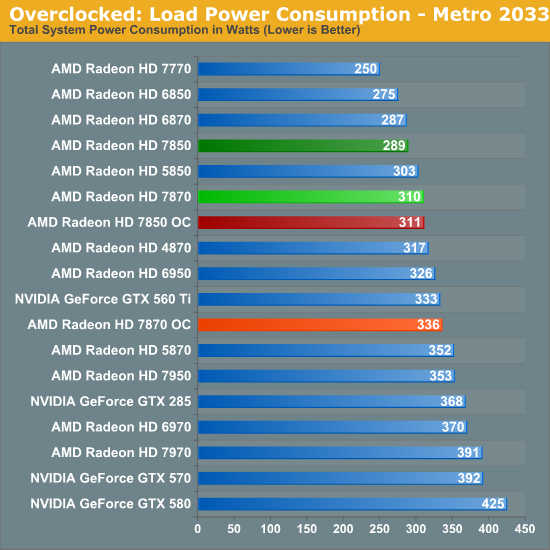
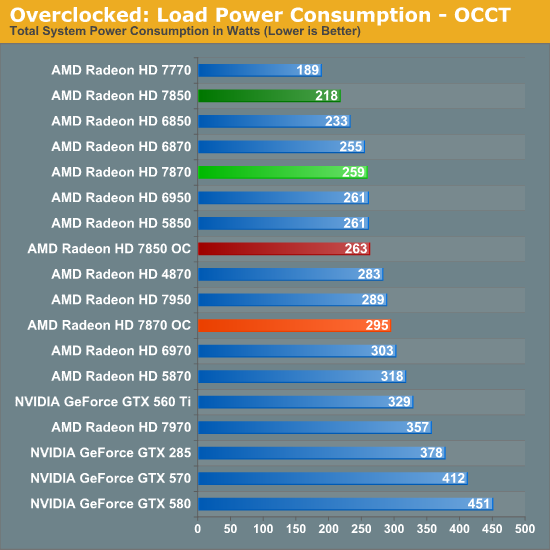
Even without a voltage increase overclocking does cause power consumption to go up, but not by a great deal. Under Metro the total difference is roughly 21W for the 7850 and 25W for the 7870, at least some of which can be traced back to the increased load on the CPU. Whereas on OCCT there’s a difference of nearly 40W on both cards, thanks to the increased PowerTune limits we’re using to avoid any kind of throttling when overclocked. All things considered with our overclocks power consumption for the 7850 approaches that of the 7870 and the 7870 approaches the GTX 560 Ti, which as we’ll see is a fairly small power consumption increase for the performance increase we’re getting.
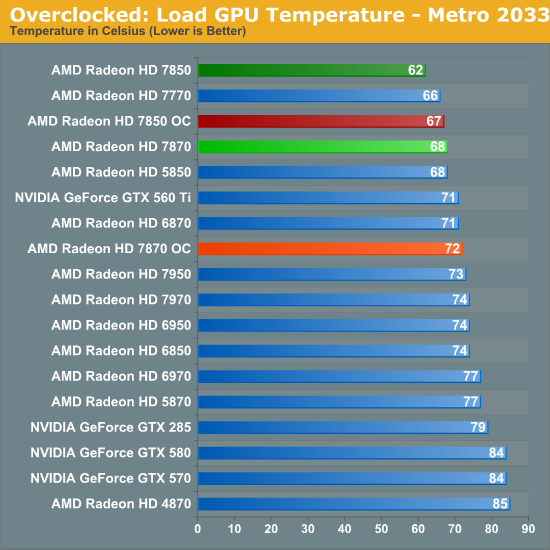
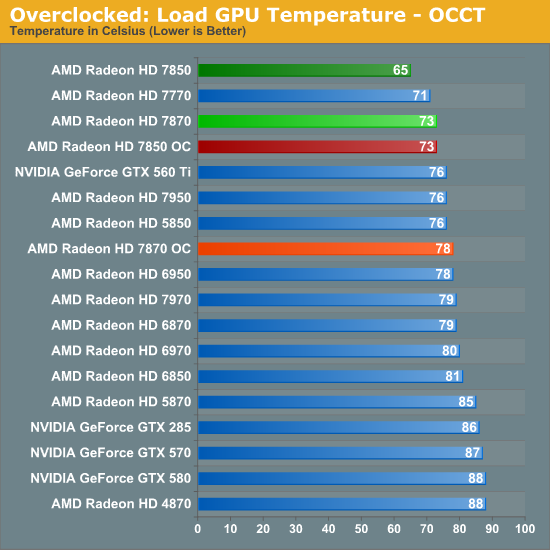
Of course when power consumption goes up so does temperature. For both cards under Metro and for the 7870 under OCCT this amounts to a 5C increase, while the 7850 rises 8C under Metro. However as with our regular temperature readings we would not suggest putting too much consideration into the 7950 numbers since it’s using a non-retail design.
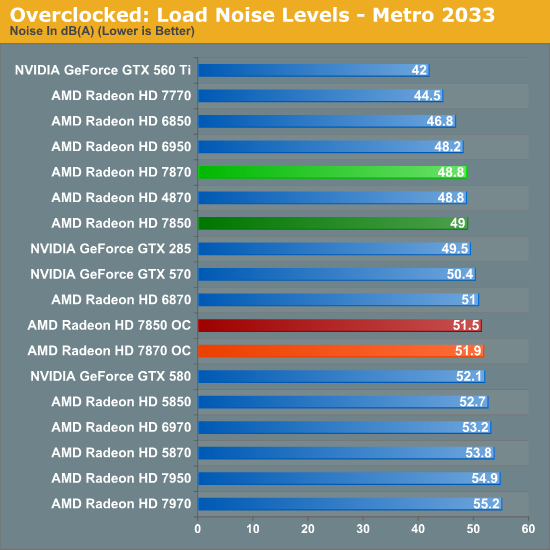
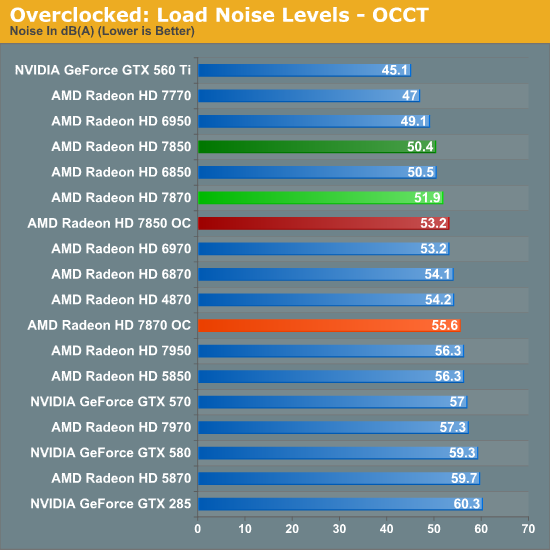
AMD’s conservative fan profiles mean that what are already somewhat loud cards get a bit louder, but in spite of what the earlier power draw differences would imply the increase in noise is rather limited. Paying particular attention to Metro 2033 here, the 7870 is just shy of 3dB louder at 51.9dB, while the 7850 increases by 2.7dB to 51.5dB. OCCT does end up being worse at 2.8dB and 3.7dB louder respectively, but keep in mind this is our pathological case with a much higher PowerTune limit.










173 Comments
View All Comments
CeriseCogburn - Thursday, March 8, 2012 - link
Yet if one is not running gigantic resolutions, they look at the usual, 1920 and 1650 p resolutions, and likely want to crank all the eye candy to the limit, which is still IMPOSSIBLE at those common resolutions with 60+ frames in so many of the popular games.So the real problem is you go from "can't do it all" to "still can't do it all" but at least you've got 40 frames going to 55 on your one screen... with maybe one more setting of 7 at ultra...
---
For others with 3x 2560 most of us really don't give a crap if they claim they get 2x frames - because if they don't have 2 or 3 or 4 of them running, they are stuck in turn down the eye candy crapsville TOO.
--
We almost always hear that we are stuck with console ports, the exact opposite of the real truth in the real problem.
A 570 is NOT ENOUGH, a 7870 is not either, nor is a 7970 for 1900x1200.
IT'S NOT GOOD ENOUGH.
SlyNine - Thursday, March 8, 2012 - link
75% was wrong, but so is 70-110% faster.Crysis 2560x1600 at the MAX settings its 20 vx 33, which is just over 60%
Drop down to 1920x1200 at the advantage drops to 50%.
Metro its 60% at max res/settings (36vs22.5)
Drop that down to 1920X1200 and its just over 50%
Dirt 3 its just over 50% at max res/settings Drop that down to 1920x1200 and its remains just above 50% ( 104 vs 68.4)
Battlefield 3 its 50% (49.7 vs 32.6) at max settings/res.
So where the heck are you getting 70% to 110% ??
2 1/2 years ago I payed around 66% of your price, and I'm getting 66% of your performence, ALMOST 3 YEARS. THIS IS NOT MOVING THINGS FORWARD
CeriseCogburn - Thursday, March 8, 2012 - link
Get back to us krummer when the 7870 is "released" and has "stable drivers" that "work most of the time" in "most of the games" and the IQ cheats of 10% driver default plus ever more now with this new blur job called MLAA and the lack of LOD bias up high enough that "in the case of SSAA" it's another low detail IQ cut down, not to mention other things like PhysX and tessellation above 10 all the way to 32...the other "unneeded" "eye candy" that "sucks" because amd sucks at doing it.*
9% , minus 10% standardized cheat, minus SSAA LOD bias cheat, minus MLAA blur cheat, minus PhysX, minus 8 other things I won't take time to mention doesn't sound like "faster" to me.
I mean come on, if the arch is so superior, why all the hack and cheats and crappy blurring and lack of features ?
Are the drivers going to be another ongoing nightmare for 47% of all ibm pc implementations ?
chizow - Monday, March 5, 2012 - link
@ Kiste: Agreed.The "competition is necessary" meme needs to die in the tech sector because it isn't necessary.
Most of this stuff doesn't expire or die on its own, not before it becomes obsolete anyways and in order for it to become obsolete there needs to be innovation and performance increases.
That's what drives innovation with technology and it certainly exists without competition.
medi01 - Monday, March 5, 2012 - link
What are you talking about, considering AMD 7850 is faster in most tests than nVidia's 80$ more expensive 570, at the same time consuming 25% less energy.Malih - Monday, March 5, 2012 - link
I think this is the decision of the new management, they decide to price something that performs better to price higher.Probably will drop the price in the future, but it would require a new release from nVidia with agressive pricing. It is rumored nVidia will release new cards near the end of March.
biassj - Monday, March 5, 2012 - link
Shitty pricing again, if the pricing was 50 bucks cheaper I would probably consider buying 7870 or 7950 at this moment. These high prices will just have me wait to see what Nvidia has to offer.piroroadkill - Monday, March 5, 2012 - link
Huh, I thought it was GTX 570 class for less.Seems solid enough.
piroroadkill - Monday, March 5, 2012 - link
For the 7850, I mean.chizow - Monday, March 5, 2012 - link
This pricing isn't nearly as bad as the 7770 or 7950/7970, but its still pretty poor overall given it once again, slides right in to existing price structures offering very little incentive to upgrade and very little price performance value compared to what has been available for 14+ months.